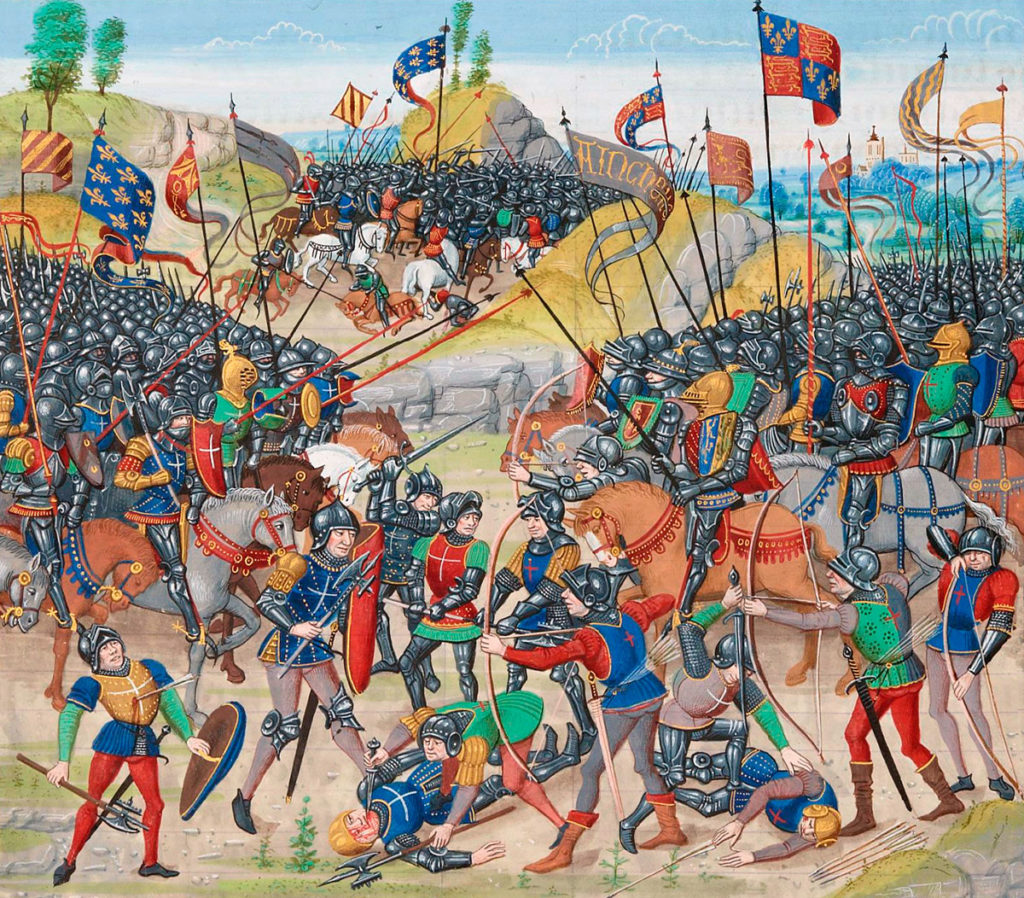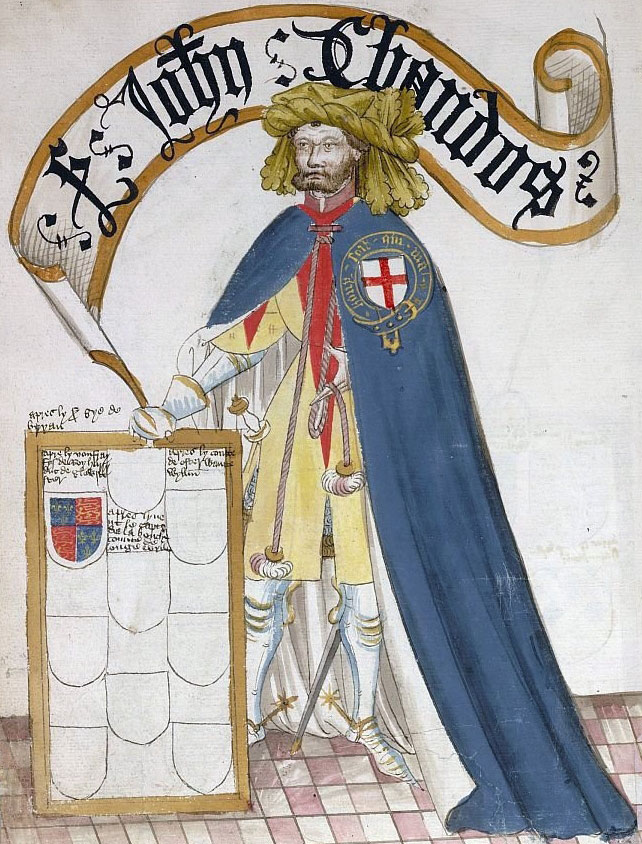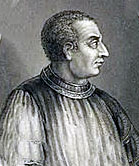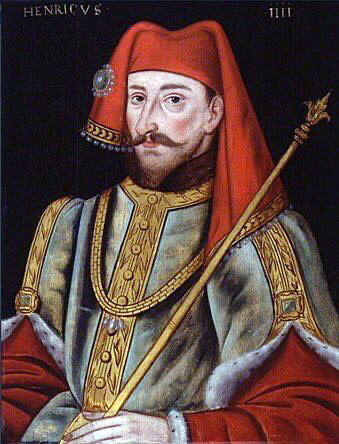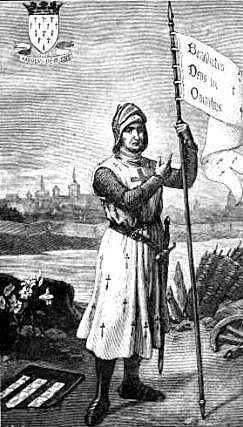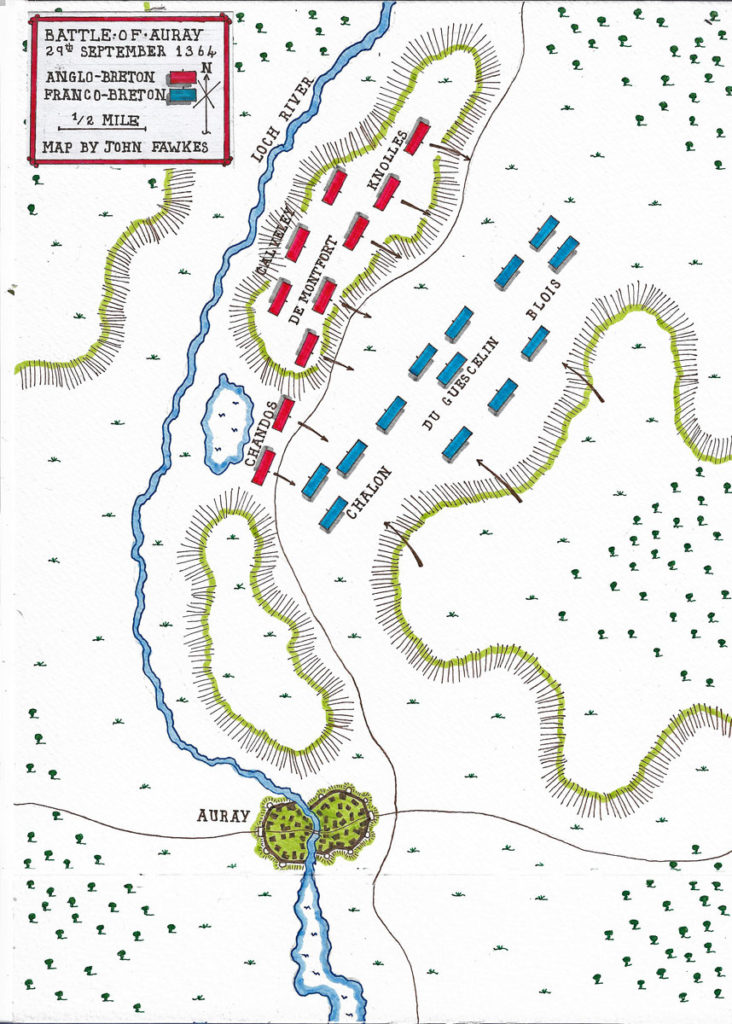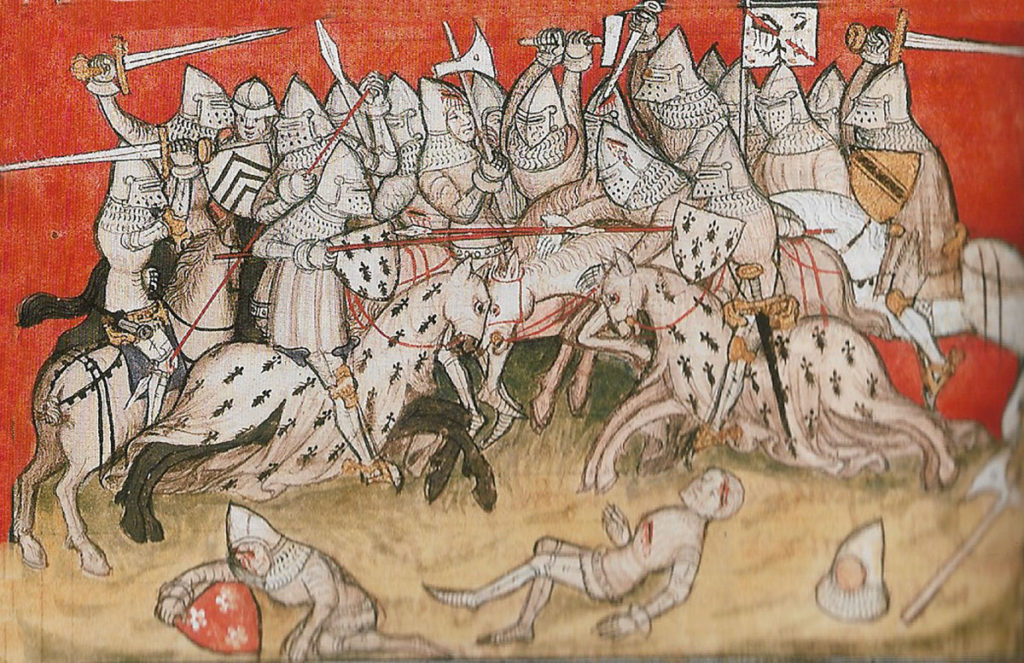The battle on 29th September 1364 in the Hundred Years War that ended the Breton Civil War in favour of the English supported candidate John de Montfort
The previous battle of the Hundred Years War is the Battle of Cocherel
The next battle of the Hundred Years War is the Battle of Najera
War: Hundred Years War.
Date of the Battle of Auray: 29th September 1364
Commanders at the Battle of Auray: John de Montfort with the English commanders, Sir John Chandos, Robert Knolles, Sir Hugh Calveley against Charles of Blois with Bertrand du Guescelin and Jean de Chalon.
Place of the Battle of Auray: outside the town of Auray on the south-west coast of Brittany.
Combatants at the Battle of Auray: The army of John de Montfort, comprising Bretons and English, against the army of his rival for the Duchy of Brittany, Charles of Blois, comprising Bretons, Normans and other French troops.
Size of the armies at the Battle of Auray: de Montfort’s army comprised around 2,000 men. Charles of Blois brought 3,000 to 4,000 men to the battle.
Uniforms, arms and equipment at the Battle of Auray: Knights increasingly wore steel plate armour with visored helmets. Their weapons were lance, shield, sword, various forms of mace or club and dagger. Many carries two-handed swords in battle. Each knight wore his coat of arms on his surcoat and shield.
English archers carried a powerful bow, from which he could discharge several aimed shots a minute.
For hand-to-hand combat archers carried swords, daggers, hatchets and war hammers. They wore jackets and loose hose. Archers’ headgear was a skull cap either of boiled leather or wickerwork ribbed with a steel frame.
Winner of the Battle of Auray: John de Montfort’s Anglo-Breton army won the battle convincingly.
Events leading to the Battle of Auray:
The 100 Years War between England and France, starting in 1345 and leading to the English victories at the battles of Creçy and Poitiers and their occupation of large parts of France, was put on hold by the Treaty of Brétigny of 1360.
In July 1364, the civil war over the succession to the Duchy of Brittany, simmering since the death of Duke John in 1340, broke out again with the English supported claimant to the Duchy, John de Montfort laying siege to the port of Auray on the south-west coast of Brittany, one of the few towns in the west of the Duchy held for Charles of Blois, the ducal claimant championed by the French.
Charles of Blois marched to relieve Auray with an army of his Breton supporters and French troops commanded by Bertrand du Guescelin, the Marshal of France and Jean de Chalon, son of the Count of Auxerre.
Neither King Edward III of England nor King Charles V of France approved of this re-kindling of hostilities, with its capacity to undermine the general peace they were trying to negotiate, even though their captains and soldiers were enthusiastic supporters of one or other of the claimants to the Duchy of Brittany.
Account of the Battle of Auray:
With the arrival of Charles of Blois’ army from the north-east outside Auray on 29th September 1364, John de Montfort’s besieging army took up position by the River Loch to the north of the town under its English commander Sir John Chandos.
Chandos and Sir Matthew Gournay held the right wing with their men-at-arms and a large contingent of archers.
De Montfort commanded the men-at-arms in the centre body, while Robert Knolles’ division took the left flank.
Much to his irritation, Sir Hugh Calveley was required to command the reserve.
Charles of Blois’ army took up a similar formation, in three divisions.
Blois commanded the right, du Guescelin the centre and Chalon the left, with a reserve in the second line.
The men-at-arms on both sides dismounted for the battle and the horses were sent to the rear, in accordance with the battlefield practice developed in the Hundred Years War, dismounted men-at-arms being less vulnerable to arrow-fire than mounted men.
There was then a period of negotiation.
John de Montfort and Charles of Blois had come near to settling their dispute before the attack on Auray.
With the armies drawn up for battle, negotiations resumed between the two claimants, with a strong possibility of a settlement whereby the duchy was divided between them.
However, the English captains were not prepared to compromise and threatened to kill Charles of Blois’s officials if they attempted to return with further proposals.
Several Of Blois’s supporters, including du Guescelin, were similarly intransigent.
Many of the Bretons in Blois’s army welcomed a peaceful settlement and with the collapse of negotiations a large body of these Bretons deserted and marched away.
A short time later the battle began.
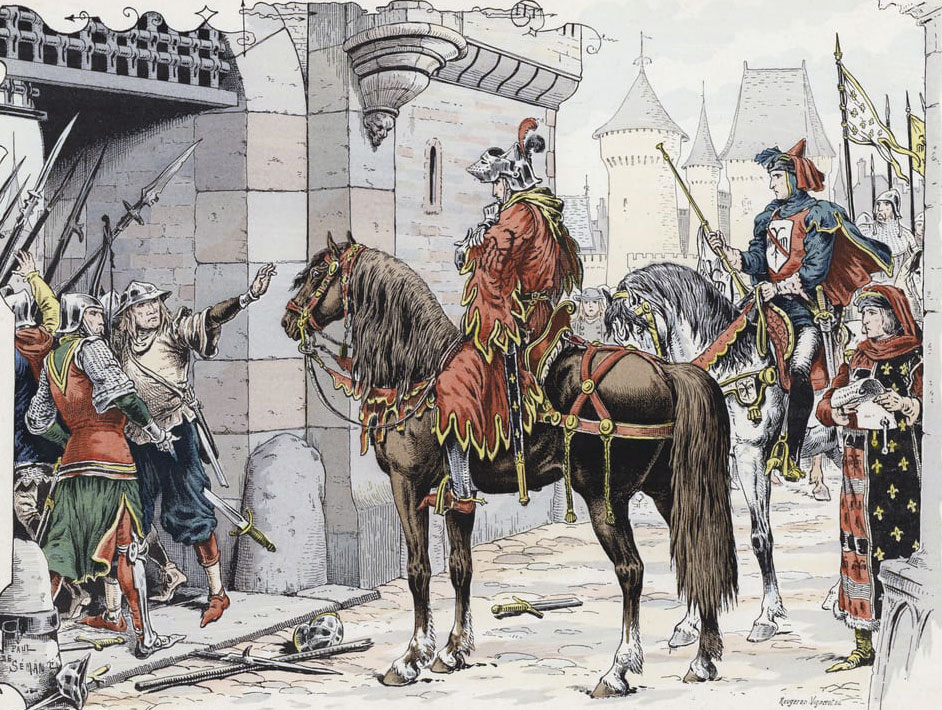
Chandos’s Anglo-Breton army clashed initially with Chalon’s right wing.
Chalon lost an eye and was captured, his men being driven into du Guescelin’s central division, catching it in the process of forming to face the threat to its right flank.
With the disarray of Blois’ centre and right wing, the Breton troops in his division on the left began to desert.
With the collapse of Blois’ left wing, Chandos and de Montfort charged Blois’ standard, which soon fell to the ground, causing the rest of his army to turn and flee.
Calverley brought up his reserve and joined the attack.
Charles of Blois’ army was routed, Blois himself being killed.
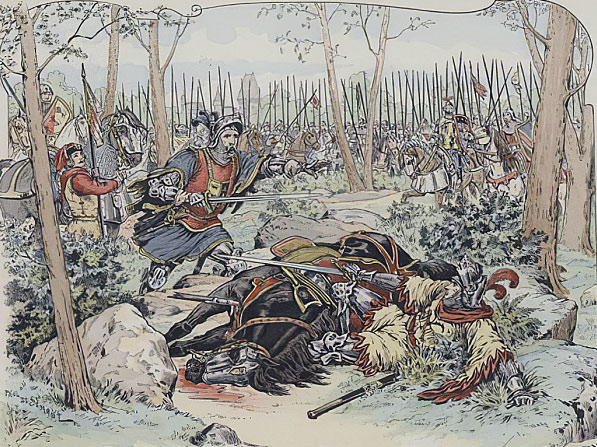
Casualties at the Battle of Auray:
As seems to have been the common outcome in medieval battles, the winning Anglo-Breton suffered few casualties, perhaps under a hundred, of which only seven men-at-arms were killed, while Blois’ Breton-French army is said to have lost 800 men killed and 1,200 captured.
Bertrand du Guescelin, his brother Pierre, his cousin Olivier de Maunay with the wounded Jean de Chalon were taken prisoner.
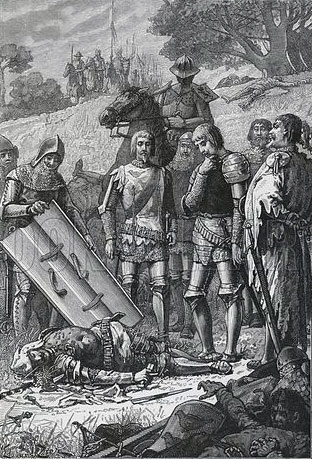
Follow-up to the Battle of Auray:
With the death of Charles of Blois in the battle, John de Montfort became Duke of Brittany.
King Edward III of England was delighted to hear his candidate for the duchy of Brittany had triumphed in the battle.
His pleasure was short-lived. On the day after the battle, John de Montfort wrote to King Charles V of France declaring his loyalty to the French Crown and offering to do homage to him.
Brittany was lost to the English king as an ally.
A number of English and Breton captains in de Montfort’s army made significant fortunes from the ransoms paid for their prisoners.
Sir John Chandos received 100,000 francs or around £20,000 from the ransom paid by the King of France for du Guescelin.
Anecdotes and traditions from the Battle of Auray:
- The English captains clearly had a low opinion of the man they were fighting for. Chandos is reported as saying to du Guescelin after the battle ‘Sir! Behold this ‘wretch’ de Montfort. By your act is he today made Duke of Brittany’.
- Charles of Blois maintained an ascetic religious life. Following his death, his cousin the French King Charles V of France began a move to have Charles of Blois canonized. He was finally beatified in 1904.
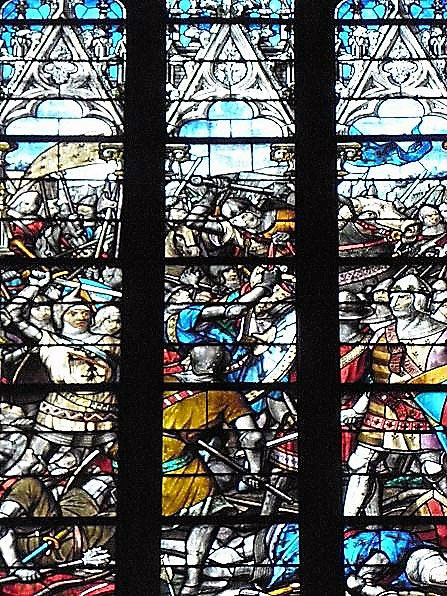
References for the Battle of Auray:
Trial by Fire, Volume II of the four-volume record of the Hundred Years War by Jonathan Sumption.
The Art of War in the Middle Ages Volume Two by Sir Charles Oman.
The previous battle of the Hundred Years War is the Battle of Cocherel
The next battle of the Hundred Years War is the Battle of Najera
